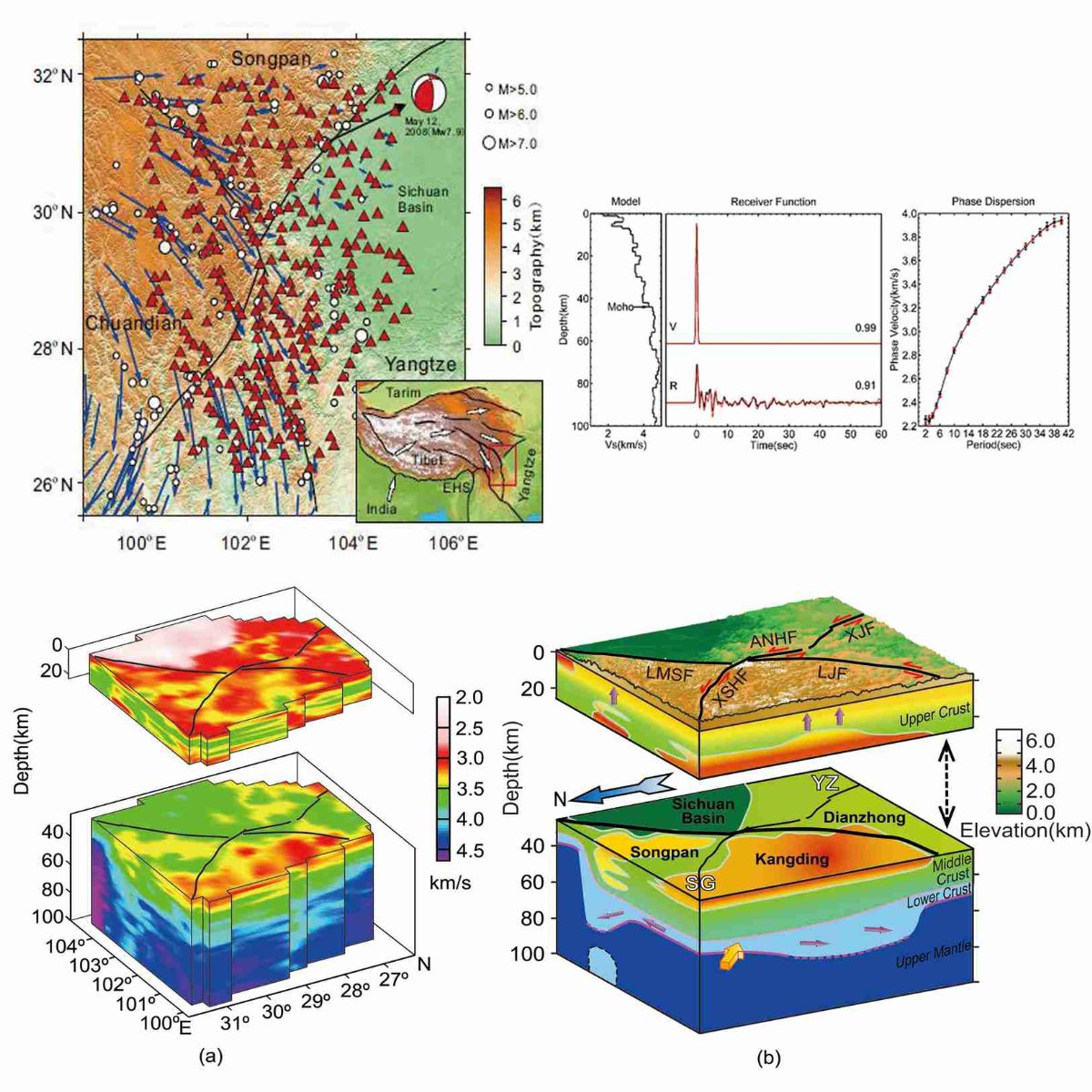台震地震学实验室
Laboratory of Lithospheric Seismic Array
中国地震局地质研究所 地震动力学国家重点实验室 State Key Laborotary of Earthquake Dynamics, Institute of Geology, CEA
Nature Geoscience: Eastward expansion of the Tibetan Plateau by crustal flow and strain partitioning across faults
INTRODUCTION: The lateral expansion of the southeastern Tibetan Plateau causes devastating earthquakes, but is poorly understood. In particular, the links between regional variations in surface motion and the deeper structure of the plateau are unclear. The plateau may deform either by movement of rigid crustal blocks along large strike-slip faults, by continuous deformation, or by the eastward flow of a channel of viscous crustal rocks. However, the importance of crustal channel flow was questioned in the wake of the 2008 Wenchuan earthquake. Controversies about the style of deformation have persisted, in part because geophysical probes have insufficient resolution to link structures in the deep crust to the observed surface deformation. Here we use seismic data recorded with an array of about 300 seismographs in western Sichuan, China, to image the structure of the eastern Tibetan Plateau with unprecedented clarity. We identify zones of weak rocks in the deep crust that thicken eastwards towards the Yangtze Craton, which we interpret as crustal flow channels. We also identify stark contrasts in the structure and rheology of the crust across large faults. Combined with geodetic data, the inferred crustal heterogeneity indicates that plateau expansion is accommodated by a combination of local crustal flow and strain partitioning across deep faults. We conclude that rigid block motion and crustal flow are therefore not irreconcilable modes of crustal deformation.
Full text and resources to the Nature Geoscience paper:
Q. Y. Liu, R. D. van der Hilst, Y. Li et al., Eastward expansion of the Tibetan plateau by crustal flow and strain partitioning across faults. Nature Geoscience, v.7, p. 361-365, 2014, doi:10.1038/NGEO2130 (PDF) (SOM)
3D crust and upper mantle model from this paper
Related papers by our group
在国家重点基础研究发展计划(973项目)的支持下,2006~2009年,中国地震局地质研究所地震动力学国家重点实验室在我国川西高原及四川盆地(100°~105°E,26°~32°N)布设了由297台宽频带地震仪组成的密集流动观测台阵(简称川西台阵),获得了2008年5月12日震惊世界的汶川地震(Mw7.9)前后的完整记录,为研究汶川大地震积累了绝无仅有的地震台阵观测资料。Science和Nature等学术刊物及美国科学促进会分别进行了专访报道(Stone R. , Science 320, 1578-1579,2008;Witze,A.,Nature 459,153-157, 2009),引起了国内外社会各界的广泛关注。国内外地震学家已经利用川西台阵的观测数据发表了一系列重要研究结果,涉及川西地壳上地幔速度结构、介质各向异性、汶川地震的衰减场、汶川地震引起的地壳同震变形等诸多问题。
最近,利用川西台阵的观测数据,中国地震局地质研究所地震动力学国家重点实验室刘启元研究员领导的研究小组与美国学者合作,在青藏高原东扩地壳变形方式及其动力学研究方面取得了重要进展。他们的研究结果已在线发表在2014年3月30日的Nature的子刊物《自然—地球科学》(Nature Geoscience)(Q. Y. Liu, R. D. van der Hilst, Y. Li et al., Eastward expansion of the Tibetan plateau by crustal flow and strain partitioning across faults. Nature Geoscience, 2014, doi:10.1038/NGEO2130)。

Upper left: distribution of the 297 stations used in this work;
upper right: an example of inverted model, receiver function and dispersion curve fitting;bottom left: 3D velocity structure of Western Sichuan region;
bottom right: dynamic model in eastern border of Tibetan plateau
该项研究的成果及其意义在于:
(1)首次给出了青藏高原东缘三维高分辨率地壳上地幔速度结构
结果表明,青藏高原与扬子克拉通的地壳厚度和速度结构明显不同。研究区地壳具有明显的、由边界断层控制的分区特征。龙门山-丽江-小金河断裂构成了青藏高原与扬子克拉通的构造边界。青藏高原东缘的上、下地壳被中地壳的S波低速层分隔。特别是,康定地块的中地壳具有异常低的S波速度(<3.3 km/s),相应的下地壳明显增厚(厚度80km左右);鲜水河断裂以北的松潘-甘孜地块的中地壳S波低速层强度较大(S波速度为3.3 km/s~3.5 km/s)。龙门山断裂西侧的下地壳明显增厚,并与地表的快速隆升相对应。由密集地震台阵观测数据得到的三维地壳结构可以很好地解释地貌、断层及地壳的运动变形,从而为研究该地区的动力学提供了前所未有的重要观测证据。
(2)提出了青藏高原东扩地壳变形方式及动力学新认识
关于青藏高原隆升的动力学机制,科学界迄今未止尚未达成统一的认识。青藏高原东扩的变形方式成为近年来争论的焦点。沿边界断层的刚性滑移挤出和下地壳流动成为青藏高原东扩的两个完全对立的端元模型。刘启元等研究结果表明,这两个端元模型并不完全对立,青藏高原东扩表现为上地壳沿块体边界断层的刚性滑移和重力势能驱动的下地壳塑形流动;青藏高原东缘中地壳低速层导致了上、下地壳的解耦。该项研究首次为青藏高原东缘下地壳塑性提供了令人信服的地震学观测证据,证明青藏高原东部的隆升主要源于:受扬子克拉通(包括四川盆地)阻挡,导致青藏高原东缘下地壳塑性变形和增厚。
(3)对川西高原地震活动方式和汶川地震成因提出了新的认识
迄今未止,科学界对2008年汶川大地震的构造成因尚未达成统一的认识。本研究结果表明,汶川地震应该看作是陆内造山过程的一次事件。其地壳动力学直接成因是在刚性四川盆地阻挡作用下,龙门山西侧下地壳的增生及上下地壳沿中地壳低速层的解耦。该项研究解释了为什么沿丽江-小金河断裂没有类似汶川地震的事件发生。
(4)在推进密集流动地震台阵数据解释方法上取得了重要创新性成果
近年来,虽然接收函数反演方法已成为研究地壳速度结构时广泛使用的重要方法。但是,由于方法本身固有的不唯一性,这种方法对于密集地震观测数据的解释遇到了困难。该项研究创新性地独立发展了基于贝叶斯理论的环境噪声和接收函数的非线性反演技术及一系列数据处理技术,并在川西台阵的数据解释中发挥了关键作用,为推进相关研究有重要作用。
Upper Mantle velocity Structure underneath the Eastern Border of the Tibetan Plateau
Related Papers:
Crust and Upper Mantle Velocity Structure of the North-eastern Tibetan Plateau
Related Papers:
Longmenshan Fault Zone and the Wenchuan earthquake
Related Papers:
Seismic ambient noise monitoring of the velocity changes associated with the Wenchuan Earthquake
Recently, technical and methodological developments have shown that such changes in material properties can be detected. Among them, ambient noise monitoring approaches, which use the coda of the noise correlation functions (NCFs), are specifically designed for continuous monitoring of temporal change in elastic properties of the medium (seismic wave speed), without repeating earthquakes or active sources.
In October, 2006, that is, well before the Mw 7.9 Wenchuan earthquake, Institute of Geology of the China Earthquake Administration deployed almost 300 broadband stations in western Sichuan province, covering 2/3 of the fault system activated during the Wenchuan earthquake. This Western Sichuan Seismic Array (WSSA) was operational for more than 2 years and provides unique continuous recordings before, during and after the Wenchuan quake. The data obtained from WSSA were used to perform a series of studies related to the genesis and process of the Wenchuan earthquake, and the structure of the Eastern Tibetan Plateau [e.g., Liu et al., 2009]. We use this data to investigate the change of crustal seismic velocity associated with the Wenchuan earthquake at the regional scale, and at different depth range and temporal resolutions.
Related papers:
Seismic Anisotropy Studies
Related Papers:
 京公网安备 11010502042766号
京公网安备 11010502042766号